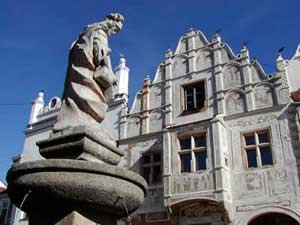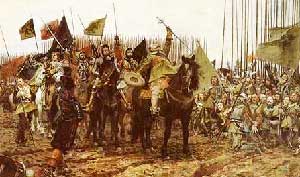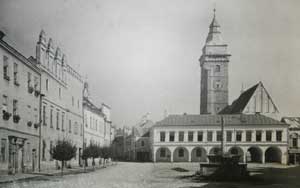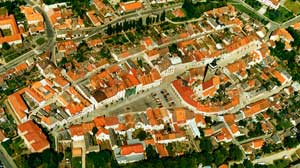Prehistory
The first settlers in this area were a Celtic tribe called the Boii. The existing Czech/Austrian border still closely follows the border that separated the Roman Empire from the Boii, and the Romans called the area across the border Boii Haemum - the homeland of the Boii - from which the word Bohemia has descended. Slavonice lies in a strategic location where Bohemia, Moravia to the east, and Austria to the south, all meet. Slavonice also lies on an ancient salt trade road, running from the Salzburg area of Austria to the northeast, dating back to at least 800BCE.
The middle ages
At the beginning of the Middle Ages Slavonice and its surroundings were covered with dense forests. Two important trading trails passed through the area - the Humpolec trail and the main road between Vienna and Prague - which was to remain a major European highway for many centuries. In the 12th century, after the Premyslides conquered Moravia, the so called Czech colonization took place, and Slavonice was established as a Slavonic settlement around the present Church of St. John the Baptist.
German settlers arrived in the 13th century and a market village came into being at the crossroad of the trading routes, and slowly grew into a town. An architectural monument from that time is the Chapel of the Holy Spirit (formerly the Corpus Christi Chapel), which was founded in the last quarter of the 13th century; several later renovations considerably changed its appearance. The first houses were made of wood, in contrast to the stone fortifications with three gates - the Upper Gate (Jemnicka), the Lower Gate (Dacicka) and the Austrian Gate, all of which were demolished more than 100 years ago.
By the late 14th century the population of the town had grown to about 500 inhabitants. In the 15th century the rulers granted Slavonice a number of privileges - annual markets, the mile privilege (which gave the town monopoly control over a wide range of production and service activities in the surrounding region) and the right to store goods.
Along with agriculture and craftsmanship, trade made up the economic basis of the town. The Church of the Assumption of Our Lady, still the largest building in Slavonice, was erected in this Gothic period. It took several decades to construct and the interior is decorated which remarkable wooden sculptures. Wooden residential buildings of this period have not been preserved, although their positions in the townscape was inherited in the layout of the Renaissance houses.
The renaissance
The Renaissance was the period of Slavonice's greatest economic strength. Several factors contributed to the boom: the establishment of a courier stop, main horse changing station, and post office on the route connecting Vienna with Prague and the fact that Slavonice came into the hands of the art-loving Zacharias of Hradec, whose government lead to the prosperity of nearby Telc as well. At the same time several new fish ponds were built and beer production developed. In terms of religion the population tended towards Protestantism.
A significant number of renaissance houses, the so-called mazhauses, have been preserved. Their facades are decorated with sgraffito (a black and white stucco technique) and they have big entry halls on the ground floor that were originally used for business and industry, with the upper floors used for dwelling. So many of these buildings have survived that the town center largely presents an entire renaissance townscape. Although there are other towns in Southern Bohemia, such as Telc, that have also preserved substantially intact renaissance townscapes, none of these are dominated by sgraffito facades. In this Slavonice is unique, and this is the basis for its current consideration for UNESCO World Heritage designation.
The Thirty Years War
In the late 17th century Slavonice went into a severe economic decline from which it has never recovered. The reasons for this were varied, but the most significant was the Thirty Years War (1618-1648). During the Bohemian Phase of the Thirty Years War (1618-1621), the protestant Bohemians rose in revolt. They deposed the Catholic Habsburgs and crowned Frederick V of the Palatinate as their King. Initially, the revolt seemed destined for success. However, Habspurg Emperor Ferdinand II struck back, subsidized by his Spanish relatives and in alliance with the Catholic League and with Lutheran Saxony. The Bohemians were utterly defeated near Prague at the Battle of White Mountain. Right before their defeat in this battle the rebels assassinated Vilem Slavata, the lord of the Manor of Slavonice, who had converted to Catholicism, by throwing him out of a window of Prague Castle.
During the Thirty Years War Slavonice suffered numerous invasions and ravages by mercenary armies and had to pay high contributions to the Swedish army who had entered Bohemia in support of the Protestant rebels. Following the eventual Catholic victory, the Emperor was given a nearly free hand to re-impose Catholicism in Bohemia, but many Protestant burghers, rather than renounce their religion, left the country and went into exile. As a result, Bohemian towns like Slavonice lost many of their business leaders.
The Austro-Hungarian empire
Subsequently, during the reign of Empress Maria Theresa, the main road and mail route from Vienna to Prague was changed to a new road through Znojmo and Jihlava, and Slavonice became isolated from its previous commercial connections. Long-term, this isolation has produced the remarkable preservation we see today. And, while many towns saw the development of industrial production during the 19th century, Slavonice did not, even though it became reconnected to the larger world as a result of rail service. the Czechoslovak Republic.
With the end of the World War 1 and the collapse of the Austrian-Hungarian Empire, the population of Slavonice was nearly exclusively German. In fact, when the Czechoslovak Republic was created in 1918, the local population did not apparently care whether they became part of Austria or Czechoslovakia.
Between 1918 and 1938 the proportion of Czechs in the population increased, but did not become dominant. During the 1930s, the Sudeten Germans were subjected to Nazi propaganda that they should be part of Germany's Third Reich rather than Czechoslovakia, and in 1938, after the Treaty of Munich, the Sudetenland was formally annexed into Germany. At this time many Czechs were forced to leave Slavonice, and, subsequently, during World War 2, its entire small Jewish community disappeared into the concentration camps.
The Communist period
However, after the end of the World War 2, these population flows were viciously reversed. Three million Sudeten Germans were ethnically cleansed from the Sudeten territories when these were restored to Czechoslovakia. Their homes were expropriated and it's believed that some 240,000 Sudeten Germans lost their lives. The majority of Czechs believe that these atrocities were a justified revenge for those committed by the Nazis against the Czechs, and in 1945 the Czech government passed amnesty laws decreeing that Czech nationals committing crimes against the Sudeten Germans would be exempt from punishment. These laws are still in effect today. The Jewish populations, many of whom had been living in Bohemia since the Middle Ages, had been extinguished by the Nazis and did not return.
Forced population movements continued under the Communists. Moscow did not want western sympathizers living close to the Iron Curtain, and moved many Czechs out of the area, replacing them with populations from the far reaches of the Soviet Union. Of the inhabitants of Slavonice in the 1930s only a few Czech families or families of mixed population remain, and constitute at most 10% of the present population. Communism left other marks, notably ugly housing projects, cultural and economic isolation, and neglected maintenance. On the other hand, some of the facades and interiors with magnificent sgraffiti were repaired and some covered up sgraffiti were uncovered, but in spite of these efforts the general state of repair of the buildings in Slavonice has remained poor.
The Velvet Revolution
During the second half of the 1980s, the general situation in Czechoslovakia became more easygoing, especially after the introduction of Perestroika reforms in the then-Soviet Union. But the Czechoslovak leadership, headed by Gustav Husak, who had assumed power after the Soviet invasion of 1968, was suspicious of attempts to "reform communism from within" and continued to toe a hard line, much to the chagrin of Mikhail Gorbachev. By 1988 there were organized demonstrations demanding change, and the six-week period between November 17 and December 29, 1989, known as the Velvet Revolution, brought about the bloodless overthrow of the Czechoslovak communist regime, and lead to former dissident Vaclav Havel's election as President of Czechoslovakia.
The new government and parliament were able to fill in many of the most gaping gaps in the Czechoslovak legal framework - concentrating in particular on the areas of human rights and freedoms, private ownership, and business law. They were also able to lay the framework for the first free elections to be held in Czechoslovakia in more than 40 years resulting in a sweeping defeat of the Communists. In the Parliamentary elections more than 96 percent of the population voted. Subsequently, the transition to separate the Czech and Slovak Republics was entirely peaceful and Czechoslovakia ceased to exist on December 31, 1992.
The Czech Republic
Prague has now re-established itself as a major European capital. Real property in Prague has been steadily appreciating for well over a decade at some 15% to 20% per annum, and construction has been booming. But most of the rural areas of the Czech Republic have seen little growth or development. The factories that the Soviet Union built in Slavonice closed down as soon as they faced real market competition, and the infrastructure does not exist to start up any new industrial enterprise. Unemployment is said to be up to three times the official figure of around 10%, and black market operations and bartering remain a major element of everyday life.
The Centre for the Future believes that Slavonice can have a successful future based on conferences, culture and education. We're investing in Slavonice; come and visit and see why this is such a special place.






